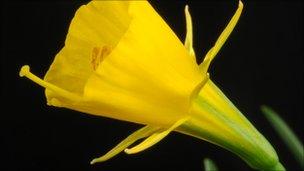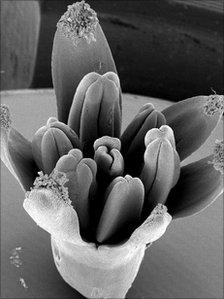Oxford scientists say trumpets in daffodils are 'new organ'
- Published

The daffodil has a large corona (trumpet) in addition to the other floral organs
A team of Oxford scientists claim to have defined exactly what the trumpet of a daffodil is.
Flowers are usually built from the same basic four parts: sepals, petals, stamens and carpels, but daffodils also have a fifth part, known as the trumpet, or corona.
Scientists have questioned since the 19th Century whether the trumpet is related to the stamens or the petals, and in the 1930s botanist Agnes Arber decided it was part of the latter.
However, after dissecting hundreds of bulbs Professor Robert Scotland and his team at the University of Oxford have suggested that the trumpet is a new organ.
"It's the way novelties evolve in nature," he told the BBC. "They don't use existing structures."
Bleeding fingers
Professor Scotland was teaching a botany field course in the Algarve, Portugal, when upon examining a Hoop-Petticoat Daffodil a student asked him what the trumpet was.
"It was one of those moments when a student asks one of the most basic questions and I looked at it and realised I had never thought about it before," Professor Scotland said.
"It niggled away at me because I wasn't able to give a satisfactory answer to the student."

During early flower development the daffodil has no corona
His team at the university decided to examine the flowers as they formed, dissecting so many of the bulbs that their fingers were bleeding from the effort.
They discovered that the other organs were made before the corona began to form.
"The four organs sit on a special little platform area and it's that platform where the corona is initiated, not as part of the petals or stamens, but actually as part of this region called the hypanthium.
"We've been able to look at very early flower development. What we've managed to document is that the whole flower is made - the sepals, petals, stamens and carpels - and at that stage there's no sign of the corona.
"All the floral groundplan is specified in floral development and then very late in the platform area there is a reawakening of some tissue that turns out to be the corona."
The daffodil is one of the most recognisable flowers in the UK and will be widely worn on St David's Day as the national flower of Wales.
Professor Scotland said: "The fascination for me has been because there are only four organs to most flowers, and because there's so many different types of flowers and that basic system is highly conserved.
"The evolution of novelty within such a highly conserved but diverse system is interesting.
"It's part of understanding the natural world. Whether that's new species, new genera or just what the trumpet of a daffodil is."